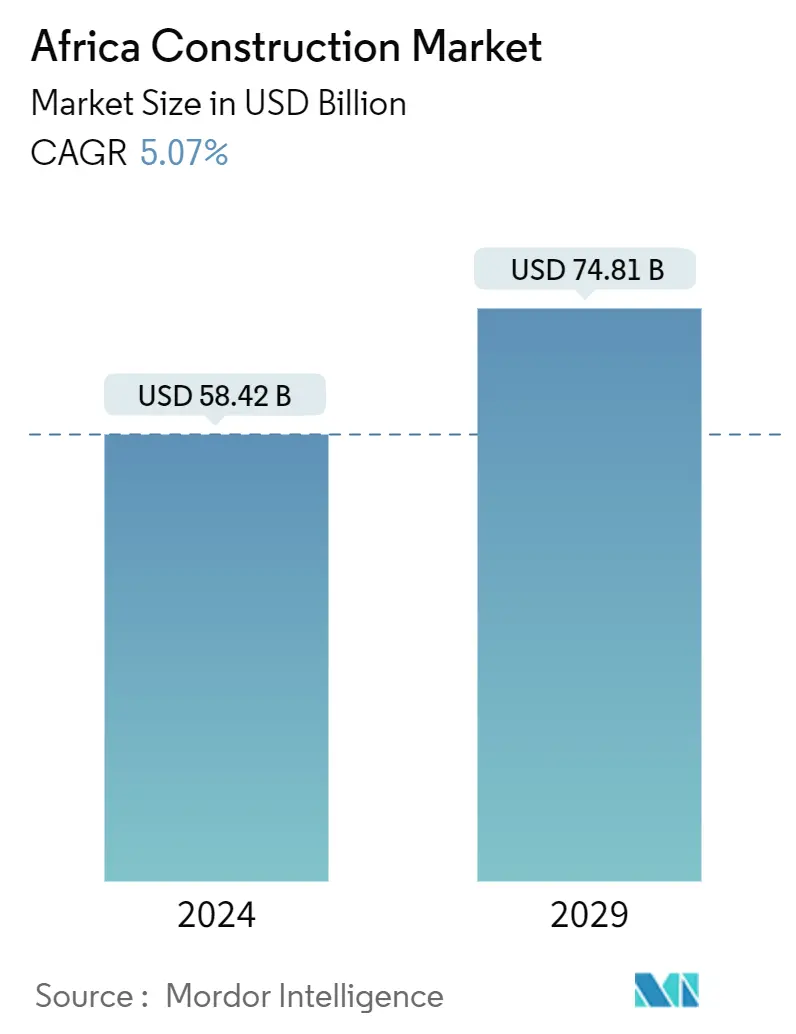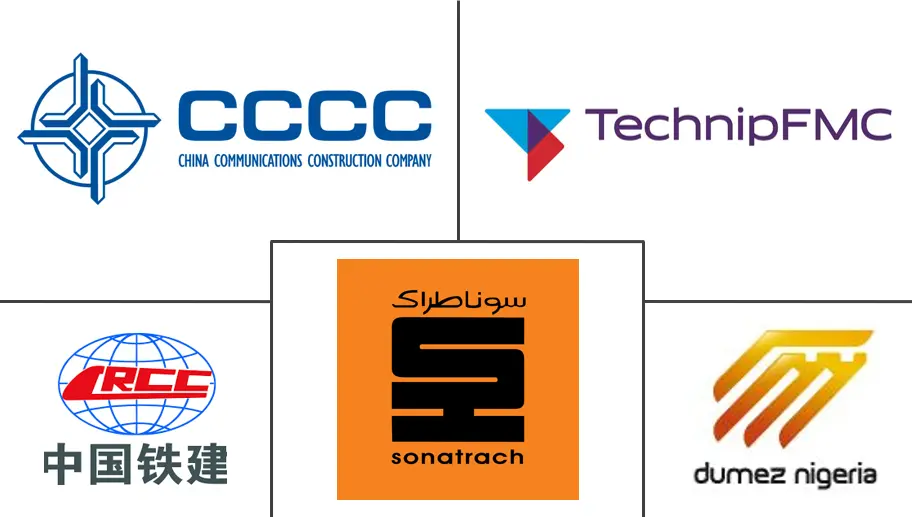Market Size of Africa Construction Industry

| Study Period | 2020-2029 |
| Base Year For Estimation | 2023 |
| Market Size (2024) | USD 58.42 Billion |
| Market Size (2029) | USD 74.81 Billion |
| CAGR (2024 - 2029) | 5.07 % |
| Market Concentration | Low |
Major Players
*Disclaimer: Major Players sorted in no particular order |
Africa Construction Market Analysis
The Africa Construction Market size is estimated at USD 58.42 billion in 2024, and is expected to reach USD 74.81 billion by 2029, growing at a CAGR of 5.07% during the forecast period (2024-2029).
- The COVID-19 outbreak negatively impacted the market in 2020. Over the next two years, growth was expected to remain affected due to the economic downturn caused by the pandemic across Africa's residential, commercial, industrial, and institutional sectors.
- Despite near-term challenges, the medium- to long-term outlook remains positive. Over the short term, investment in the construction industry may be driven by government spending in the infrastructure sector.
- The African construction industry is the target destination for most large economies because of accruing benefits, such as the availability of natural resources, huge investment opportunities in energy and infrastructure, cheap labor, and a fast-growing consumer market.
- The country also has a beneficial business environment that includes favorable economic development policies, rising commodity prices, continued progress in the fight against corruption, and the adoption of democratic governments.
- Business confidence is predicted to grow due to the government's assistance for small and medium enterprises (SMEs). In November 2021, the National Treasury announced its plans to spend ZAR 2.3 billion (USD142.4 million) in the current FY (April 2021 to March 2022) to help businesses affected by the third wave of the pandemic and rebuild infrastructure damaged by the civil unrest that erupted in Gauteng and KwaZulu-Natal provinces in July 2021.
- The total value of registered building plans passed by larger towns increased by 37.5% Y-o-Y in the first 10 months of 2021, following an annual fall of 33.5% in 2020, according to Stats SA. In February 2021, the government announced the investment of ZAR 791.2 billion (USD 49 billion) in public-sector infrastructure investment over the Medium-Term Expenditure Framework (MTEF) term, which runs from FY2021/2022 to FY2023/2024. The transport and logistics sector received ZAR 287 billion (USD 17.8 billion), while the energy sector received ZAR 149.9 billion (USD 9.3 billion).
Africa Construction Industry Segmentation
Construction is a very diverse industry that includes activities ranging from mining, quarrying, and forestry to constructing infrastructure and buildings, manufacturing and supplying products, and maintenance, operation, and disposal.
The African construction market is segmented by sector (commercial construction, residential construction, industrial construction, infrastructure (transportation) construction, and energy and utility construction) and by construction type (additions, demolition, and new construction, by region (Eastern Africa, Western Africa, Southern Africa, and Northern Africa).
The report offers market size and forecasts for the African construction market in value (USD) for all the above segments.
| By Sector | |
| Commercial Construction | |
| Residential Construction | |
| Industrial Construction | |
| Infrastructure (Transportation) Construction | |
| Energy and Utilities Construction |
| By Construction Type | |
| Additions | |
| Demolition | |
| New Constructions |
| By Region | |
| Eastern Africa | |
| Western Africa | |
| Southern Africa | |
| Northern Africa |
Africa Construction Market Size Summary
The African construction industry is poised for significant growth, driven by substantial investment opportunities in infrastructure and energy sectors. Despite the initial setbacks caused by the COVID-19 pandemic, which impacted various sectors across the continent, the medium- to long-term outlook remains optimistic. The industry benefits from Africa's rich natural resources, affordable labor, and a rapidly expanding consumer market. Government initiatives and favorable economic policies are expected to further stimulate growth, with increased spending on infrastructure projects. Major cities are undergoing transformative changes with large-scale construction projects, including skyscrapers and smart cities, which are reshaping urban landscapes and addressing the needs of growing populations.
China's substantial economic presence in Africa, through investments and development projects, has significantly influenced the construction market. The Belt and Road Initiative has facilitated major infrastructure projects, particularly in transportation and energy, across several African nations. Despite a slight decline in investment in Sub-Saharan Africa, China remains a key player, funding numerous rail and energy projects. The African construction market, while less competitive, offers growth potential, attracting major international players. This consolidation is expected to enhance market competition, with significant contributions from companies like Vinci, Bouygues, and Chinese construction giants. Recent developments, such as renewable energy projects and data center expansions, underscore the industry's dynamic nature and its capacity for continued growth.
Africa Construction Market Size - Table of Contents
-
1. MARKET INSIGHTS AND DYNAMICS
-
1.1 Current Economic and Construction Market Scenario
-
1.2 Technological Innovations in the Construction Sector
-
1.3 Impact of Government Regulations and Initiatives on the Industry
-
1.4 Review and Commentary on the Impact of International Construction Market and Growth Potential for the Industry in the Major African Economies.
-
1.5 Review and Commentary on the Chinese Infrastructure Projects and BRI Initiative
-
1.6 Comparison of Key Industry Metrics of African Countries (Analyst View)
-
1.7 Comparison of Construction Cost Metrics of African Countries(Analyst View)
-
1.8 Impact of COVID-19 on the Market
-
1.9 Market Dynamics
-
1.9.1 Drivers
-
1.9.1.1 Rapid urbanization driving the market
-
1.9.1.2 Economic development
-
-
1.9.2 Restraints
-
1.9.2.1 Political and Regulatory challenges
-
1.9.2.2 Skills and Labor Shortages
-
-
1.9.3 Opportunities
-
1.9.3.1 Affordable housing
-
1.9.3.2 Renewable energy
-
-
-
1.10 Industry Attractiveness - Porter's Five Forces Analysis
-
1.10.1 Bargaining Power of Suppliers
-
1.10.2 Bargaining Power of Buyers/Consumers
-
1.10.3 Threat of New Entrants
-
1.10.4 Threat of Substitute Products
-
1.10.5 Intensity of Competitive Rivalry
-
-
1.11 Industry Value Chain Analysis
-
-
2. MARKET SEGMENTATION
-
2.1 By Sector
-
2.1.1 Commercial Construction
-
2.1.2 Residential Construction
-
2.1.3 Industrial Construction
-
2.1.4 Infrastructure (Transportation) Construction
-
2.1.5 Energy and Utilities Construction
-
-
2.2 By Construction Type
-
2.2.1 Additions
-
2.2.2 Demolition
-
2.2.3 New Constructions
-
-
2.3 By Region
-
2.3.1 Eastern Africa
-
2.3.2 Western Africa
-
2.3.3 Southern Africa
-
2.3.4 Northern Africa
-
-
Africa Construction Market Size FAQs
How big is the Africa Construction Market?
The Africa Construction Market size is expected to reach USD 58.42 billion in 2024 and grow at a CAGR of 5.07% to reach USD 74.81 billion by 2029.
What is the current Africa Construction Market size?
In 2024, the Africa Construction Market size is expected to reach USD 58.42 billion.

